Wild rose - what kind of flower is it?
The second and most common name of the flower is rosehip. In total there are more than 75 species of this shrub. The plant belongs to the Rosaceae family. Almost all types of rose hips are found in all regions of the country.
Interesting! You can tell the time by the wild rose, since its flowers open and close strictly at a certain time.
Rosehip berries
Description of what it looks like
Description of wild rose:
- life form - bush;
- the stems are most often green, covered with many small thorns;
- the flowering period lasts from the second half of May and ends in mid-summer;
- the fruits ripen in September;
- the flower is simple, with many stamens;
- the color depends on the variety (from white to bright pink);
- The colors of the fruits are also varied.
Self-pollination of a flower rarely occurs; more often, the attraction of pollinating insects is required, which willingly flock to the pleasant, bright aroma of the flower.
Healing properties, use on the farm
The fruits of the plant have medicinal properties and help with colds, coughs, and bronchitis. They are simply added to tea, brewed as a tea drink, or compote is made from the fruits to strengthen the immune system. The berries of the plant contain a huge amount of vitamin C.
Medicinal properties
Many plants that bloom in spring, in addition to their beautiful appearance, also have beneficial properties. One of them is rose hips, which is one of the plants that are not only very impressive, but, first of all, support the immune system. And all this is due to the large amount of vitamin C contained in its fruits. Therefore, it is not surprising that it is so often used in the treatment of colds, influenza or a general state of exhaustion of the body. Let us remember, however, that the effect of rose hips is not limited solely to vitamin C, since the composition also contains bioflavonoids that resist free radicals and other valuable substances, although to a lesser extent - vitamins B1, B2, E, A and K. Rosehip also helps treat urinary tract diseases
, in particular stones or sand in the kidneys.
In addition, it is very effective for joint inflammation and rheumatic symptoms. WAYS TO USE ROSE HIP. Both fruits and flower petals are suitable for culinary and medicinal purposes.
Healthy fruits serve as a base for juices, syrups, jams or infusions, but it is worth remembering that the vitamin C they contain can be radically reduced as a result of cooking foods at high temperatures for too long. Fruits are also an important component of many medicinal herbal mixtures.
In turn, rosehip flowers are used in the cosmetics industry. The oil obtained from the fresh petals is often used as an ingredient in perfumes, but is also added to creams or soaps. As you can see, regardless of the form - be it in the form of products, cosmetics, or medicinal products - it is worth using the beneficial properties of rose hips. Growing it, contrary to appearances, will not cause you much trouble, and in return you will be endowed with a wealth of useful vitamins and microelements that have a good effect on our body.
Varieties of wild roses for growing in the garden
What is the name of an indoor flower with red leaves?
Wild rose bushes are often grown to improve the appearance of courtyards and park areas, and are grown as hedges and in garden plots. The plant is especially suitable for busy gardeners who want their garden to look as attractive as possible with a minimum of effort.
Dog rose (Canina)
The most common type of shrub, which is used to create living fences. Large fragrant flowers of bright pink color bloom in early summer, and closer to autumn the berries begin to ripen. The maximum height of the bush is 3 m. The plant is very unpretentious and requires virtually no care.
French (Gallica)
French rosehip grows only in the southern parts of Russia and European countries. The bush is low-growing, the height of the stems does not even reach 1 m. The flowers are bright red. It can be grown as a houseplant.
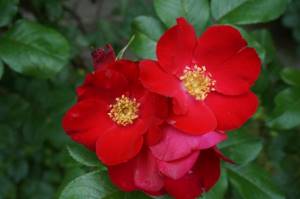
French rosehip
Devil's Rose Lakorn
This low-growing plant has no thorns at all on its thin long stems. The peduncles are long, bearing large bright flowers. There are small sticky droplets on the fruits and stalks that give Lakorn its original appearance.
Moyes Wild Rose
The Moyes rose species includes several ornamental flowers with large bottle-shaped fruits and bright red flowers. The leaves are bright green, against their background the flowers look especially impressive.
Wild rose Althea
The marshmallow variety is a perennial herbaceous shrub reaching 2 m in height. The root system is very powerful, there are no thorns, instead the stems and leaf petioles are covered with villi. The flowers are large, white-pinkish in color, located on short peduncles.

Variety Althea
rust rose
This plant has the appearance of a shrub about 1.5 m high, but can grow up to 2.5 m. The stems are covered with large thorns. The leaves are green, up to 12 cm, with seven leaflets. The flowers are pale pink. The fruits are red, spherical in shape.
Rosa Hugonis and others
This is a wild yellow rose that blooms first among varieties. The flowers are pale yellow, located on short stalks throughout the shoot. The bush has many thorns and has high immunity. It grows very quickly, growing up to 2.5 m.
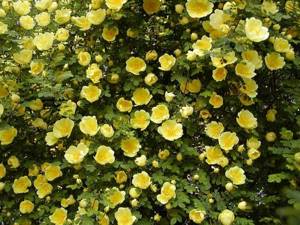
Rosa Hugonis
In addition to those presented above, flower growers also grow other varieties of rose hips. White wild rose and cinnamon rosehip are often found.
Features of planting and caring for crops
What to do if a rose turns into a rosehip
Almost all varieties of wild rose reach a height of more than 2.5 m. Rose hips will grow well in lighted areas. In shading, flowering will be short-lived, and fruiting may be practically absent. Fruits begin to appear only in the second year of the seedling’s life. Rose hips can take root even in poor soil thanks to a well-developed root system that penetrates to a considerable depth. Wild rose is frost-resistant and can survive prolonged rains.
When planting a seedling, it is important to add fertilizer to the planting hole:
- 1 tbsp. a spoonful of potassium salt should be mixed with 2 tbsp. spoons of superphosphate.
- Add 6 liters of horse manure to the resulting mixture and mix the ingredients.
- Fertilizer is applied to the planting hole and sprinkled with soil on top.
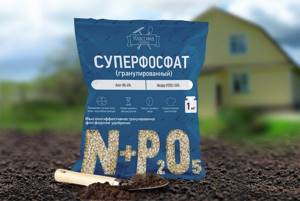
Superphosphate
To get a good rose hip harvest you will need:
- When planting seedlings horizontally, deepen them a little more than the situation usually requires.
- The above-ground part is shortened in such a way that only 1/3 of the length is left.
- The soil around the stem part of the bush is compacted, abundantly moistened and mulched.
- The root shoots that appear can be left only in the first year after planting the seedling. Only the best shoots can be left in subsequent ones.
- Branches of zero orders may not be shortened. Fruits and flowers remain on their tops. Only 12 months after planting can these branches be shortened.
- On a two-year-old branch, last year's lateral growth can be shortened so that 2-3 buds remain.
- Following all the rules and recommendations, 4 years after planting, you can collect 9-11 kg of berries from each bush, and each one will be large.
- The fruits should be collected in early September. At this time, they usually acquire a bright red or brown color.
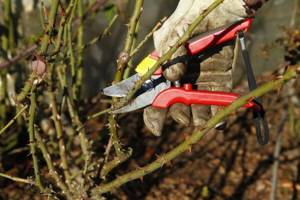
Pruning roses
You can propagate wild roses:
- offspring;
- green cuttings;
- root cuttings.
The latter method is used to preserve the characteristics of the mother plant in the offspring. Propagation by root cuttings is accessible even to a beginning gardener. This is the easiest way to propagate this plant. A week before planting, you should start preparing root cuttings. Their length should be within 10-12 cm. Then they are planted horizontally to a depth of no more than 15 cm. Before the first shoots appear, the soil on the site should be systematically loosened, moistened and cleared of weeds. As soon as the sprouts reach 2 years of age, they can be transplanted to the selected area.
Note! If desired, you can propagate wild roses by seeds. They should be sown in late August or in the spring, when frosts have passed. In this case, stratification may be required.
Growing wild roses, how to plant them correctly in open ground
What is the name of an indoor flower with red flowers?
Growing wild roses and planting them does not cause much trouble for the gardener. This is a rather unpretentious plant.
What time does boarding take place?
Young plants can be planted at any time. The optimal period for planting in open ground is early spring, when young shoots have given a small increase.
Selecting a location
Any location is suitable for rose hips, but in shaded areas it will not bloom for long, and fruits may not form at all. The bush is growing quickly. It is worth selecting a wide area for it in advance, since transplanting the plant to a new location will be problematic.
How to prepare the soil and flower for planting
The soil should be fertilized and the planting hole should be prepared. The roots of the seedling are treated with a solution of potassium permanganate. They need to be inspected and all damaged parts removed. The main roots are shortened by several centimeters.
Step by step landing procedure
- For each plant, prepare a hole 50x50x50 cm.
- 10-15 kg of compost, 200 g of superphosphate, a little potassium chloride and ammonium nitrate are added to the pits.
- The top of the bushes is cut to 15 cm.
- 10 liters of soft water at room temperature is poured into each hole.
- Prepared seedlings are placed in the hole and sprinkled with soil. The top layer should be slightly higher than the level to which the bush was deepened in the planting container (about 5 cm).
- Next, the rose hips are watered, the soil is compacted a little and mulched with sawdust, peat or moss.
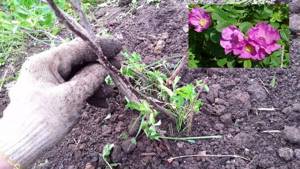
Planting rose hips in open ground
How and when to plant lavatera seeds
Growing lavatera from seeds is a simple and affordable way to get khama in the garden. It is recommended to sow seed material in April-May. A prerequisite is thorough digging of the soil and application of fertilizers. For 1 m² you will need to add 10 liters of humus or compost, with the addition of 2 tbsp. l. nitrophoska.

Then the soil is carefully leveled, holes are made in it up to 0.01 m deep. A prerequisite is to moisten the furrows; only after this is sowing performed. The hole is filled with garden soil from above and covered with cling film. You can observe the first shoots after 7-9 days, but removing the cover is allowed only after the bushes reach a height of up to 5 cm. During this period, the seedlings are thinned out, and the area is slightly loosened. If you have not fertilized the soil beforehand, this can be done immediately after removing the protective material. A complex mineral composition is used for feeding.
Seedling growing method
Garden rose lavatera is also excellently grown from seedlings. This method allows you to get faster flowering. You can sow the crop with the arrival of March. It is very important to properly prepare containers for planting. A drainage layer must be placed at the bottom of the containers, and a soil layer is laid on top. Next, the ground is watered with warm liquid, and the seed material is buried into it (no deeper than 1 cm). The crops are covered with film or a piece of glass. The boxes are placed in a warm, well-lit place.
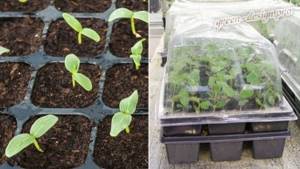
It is recommended to periodically remove condensation from the surface of the glass and moisten the soil. After 14 days, the first shoots can be observed. In order for the plants to form beautifully and correctly, they need to be illuminated. If this is not done, they will stretch out greatly and become thinner.
After seed germination, the glass is removed. Further care consists of systematic watering of the crop. There is no need to pick a wild rose, since the lavatera flower is immediately planted in the flower garden.
Difficulties in growing Lavatera flower
Lavatera flower is a problem-free crop. But there are still several problems that gardeners may encounter. Aphids can cause great harm to the plant. It affects lavatera leaves and stems. To combat the pest, it is recommended to use the product “Aktara”.
Another common problem is rust. It can be recognized by brown, brown or yellow spots on the leaves. First of all, all infected parts of the crop are removed, after which the wild rose is treated with Topaz or Kuproxat; Bordeaux mixture is also suitable. Severely damaged specimens are removed from the site and burned.
Plant care
Indoor bride flower - what is the name of the plant?
Wild rose does not require additional care. This is an option for beginner gardeners and for those who do not have a lot of time to work in the garden.
Watering rules and humidity
Rose hips can adapt even to hot, dry weather. During periods of extreme drought, you can water it. At the same time, 10-15 liters of water are poured under each bush, no more. You should not water a wild rose more than 3 times during the season.
Fertilizing and soil quality
The flower needs feeding only in the first years of life; it needs both mineral and organic fertilizers. The main thing is not to overdo it with nitrogen, otherwise problems with flowering may begin.
Pruning and replanting
The first drastic pruning is done after planting, if the shoots were not shortened initially. Then only formative pruning is required, which is carried out once every 3 years.
Features of wintering a flower
Most types of rose hips tolerate winters, even harsh ones, calmly. It is better to cover the delicate southern variety of the bush with a special protective material.
Rosehip - how to grow it?
Contrary to popular belief, growing rose hips is not burdensome or difficult. However, before you start planting it, you should choose an appropriate place for this. If you want to cultivate a wild rose, you must take into account the fact that it grows a lot. Therefore, it is necessary to allocate a lot of space for it. It is best if it is light, because then the rose blooms much more profusely. It should also be remembered that the soil should be moderately moist, and if necessary, enriched with compost. In addition, the plant is completely frost-resistant, so it does not require covering for the winter. So you can plant it in the fall or early spring. The next step is to apply fertilizer. Unlike many flowering shrubs, rose hips do not require regular fertilization, provided they are growing on an abundant surface. Otherwise, it is worth investing in fertilizers.
Rose blossom
The shrub usually blooms actively and for quite a long time.
Period of activity and rest
The period of activity begins in April, when the buds are laid. Wild roses bloom in mid-July.
Care during and after flowering
The rules of care during this period remain the same as the rest of the time. No additional effort required.
What to do if it doesn’t bloom, possible reasons
Rose hips begin to bloom the next year after planting, so you should not wait for flowering in the first year of life. The reasons for the lack of flowering may be too much shading of the bush or excess nitrogen in the soil.
Diseases, pests and ways to combat them
Rose hips are almost not susceptible to attack by insect pests or diseases. If this happens, you will need to use chemicals and insecticides. In the initial stages of damage by insect pests, folk recipes, for example, a solution of garlic or iodine, help.
Wild rose is a flower that decorates not only forest slopes, courtyards or parks, but also the flower beds of flower growers who want to choose something simple, beautiful and useful for themselves. The bush creates beauty in any garden plot where it is located. Caring for rose hips is not at all difficult. As it grows, it looks extraordinary, representing entire thickets.











